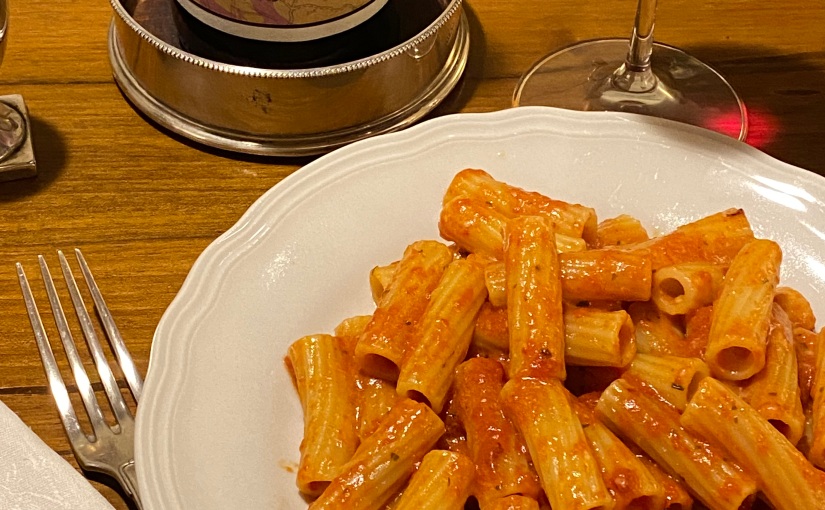A post from the Fanciulle Vini blog.
Tuscan cuisine is ostensibly simple: a few, fresh ingredients, combined quickly and served casually. And yet, “Things are so black-and-white in Tuscan cooking,” says Fanciulle winemaker, Jem Macy. “The rigidity at the backbone of Tuscan meals is ridiculous.” Only perfectly-honed habits can explain how well people eat in a region where there is no “haute cuisine.” There are rules on everything down to how to boil water. Can outsiders really learn how to cook like locals when the Tuscans’ cooking approach seems instinctive rather than learned? Can we master the basics when they’re not even written down anywhere? Let’s hope the answer is yes, because nothing brings out that glorious, mouthwatering tang of a Tuscan Sangiovese wine like a Tuscan dish—cooked how it’s done in a Tuscan home.
This series of posts, drawn from Jem’s kitchen practices and wealth of knowledge, and recipe-tested by food writer Valerie Stivers, will bring real Tuscan cooking to your home.
The ingredients for pomarola pasta sauce are indeed simple: fresh or canned passata di pomodoro, olive oil (last year’s for cooking, this year’s for a condiment), garlic, ‘short’ pasta (in Italy, it seems, folks can’t be bothered to twirl spaghetti anymore), and grated parmesan.
At Fanciulle, Jem makes dozens of jars of passata di pomodoro every year, from gardens that produce up to “a wheelbarrow a day” of tomatoes during the month of August. (Her secret for canning tomatoes: quarter them, drain them in a colander for a couple of hours, cook till slightly softened, and mill.) Her jars of passata usually last until just about this time of year. “It’s like eating sunshine in February,” she says. “The sweet, soft tomatoes remind you spring will eventually come.”
If you don’t have homemade, use canned passata, a form of pureed, strained, uncooked tomatoes, which you can find in the canned tomato aisle at better-quality supermarkets. (I found several varieties at my local Whole Foods in Brooklyn, New York.) To make a simple sauce, lightly brown two cloves of garlic in olive oil, add the passata, cook for a few minutes on high heat, until it starts to boil, and you’re done. Remove the cloves of garlic before serving and season to taste.
If anything, there’s more to know about cooking the pasta. Most Italians buy Barilla. The tradition of making the regional pasta shape by hand has mostly passed away with the previous generation of grandmothers. And “Italians are psycho about the right cooking time,” Jem explains. “They never wing it. Never. Is pasta cooked on a timer? Absolutely. They also taste it, but just to prove how tricky the timing is.” (FYI, the all-important cooking-time is printed on the package.) And, to make the process even more rigid, the water must be at a rolling boil before it gets salted (otherwise the salt can settle on the bottom and cause pitting in stainless steel pans) and before the pasta goes in, for the cooking time to be accurate. N.B. (“nota bene” Italian for “note to self”): Use large sea salt. Always.
To discover whether these infinitesimally small guidelines really mattered, I made four pots of pasta, two using Whole Foods-brand penne and two using specialty cavatelli from Frankies 457 Spuntino, an Italian restaurant in Brooklyn that has its house line of pasta made in Italy. I boiled the water correctly for one of each and cooked the pasta on a timer, and for the other two just threw the pasta in, winging it, as is my fashion. The differences were subtle but real, apparent for both pastas but more-so for the expensive cavatelli. The correctly-timed pasta produced a plate that had that ineffable satisfying chewiness—an ubiquitous staple was elevated, I dare say, to nearly restaurant-level.
I also compared a sauce made using passata with one made using canned whole tomatoes that I pureed myself, my usual trick for winter red sauce. The one made with passata was hands-down better: the resulting sauce had a velvety, unctuous quality that again evoked restaurant food. Mixed with freshly grated Parmesan cheese and a bit of basil, the tomato and herb notes in this simple dish were the perfect accompaniment for a glass of Fanciulle wine. And a last N.B.: The best part is the scarpetta, sopping up the leftover sauce with the bread—it’s bad manners but irresistible.
—Valerie Stivers

Valerie Stivers is a freelance journalist and the author of “Eat Your Words,” a long-running food column for The Paris Review that creates recipes based on food scenes in classic literature. Her work has also appeared in The Wall Street Journal, Travel+Leisure, Food52 and Edible Jersey. Follow her at @ivalleria and stay tuned here for more of her beautiful cooking!

